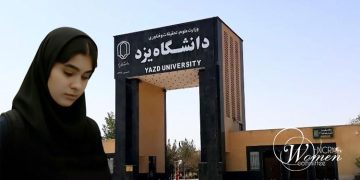NCRI Women’s Committee Monthly Report – May 2018
Iran’s women workers oppressed in silence and darkness
The working conditions of Iran’s women workers are grossly different from those of their male counterparts. Their plight is rarely seen or spoken about. Women’s participation in the workers’ movement is unnoticeable and they are oppressed in silence and darkness.
Women suffer from double oppression partly because they are rarely hired in official jobs due to provisions of the Iranian laws which give priority to men.
In contrast, women comprise the greater portion of workforce in unofficial workshops not monitored by the government and are greenlighted to pay less to their workers and deny them benefits or insurance. Women who are desperate to have any job to earn their family’s living are widely preyed upon by such workshops.
A large number of women sell their work force for a small amount of money without being felt or considered as a worker. They work between 10 to 12 hours at home applying glue on envelopes or sewing spangles on fabric, but their daily wage is around 5,000 toumans or merely a dollar. These women even do not have a specific employer and their products are sold through intermediaries who pocket most of their revenues.
At the same time, the status of Iranian workers is an off limit and the occasional inquiries and data published in this regard fail to address the number of women and the problems they face in this male-dominated environment, under discriminatory laws.
However, a few reports and interviews which appeared in the Iranian media (both state-run and freelance) on the occasion of May 1, the International Workers Day, shed light on a small portion of the deplorable situation of women in this field.
Official admissions to “new slavery” conditions
In a gathering on April 28, at the Labor Ministry in Tehran, Massoumeh Ebtekar, Rouhani’s deputy for Women and Family Affairs, confessed that “women have the largest share in unofficial jobs.”
The state-run IRNA news agency wrote that unofficial jobs are referred to jobs which are outside the official structures; in a word, they are jobs in units which are not officially registered and not monitored by the government. Those hired for unofficial jobs are counted in the statistics as “employed” but are not granted any medical or retirement insurance.
Alireza Mahjoub, General Secretary of the House of Workers (a government foundation) and member of the Social Committee in the mullahs’ parliament, also admitted that “women have the highest rate of unemployment” and “women’s economic participation is not noteworthy.” (The official IRNA news agency – April 28, 2018)
In another gathering in Qom, on April 30, 2018, Ahmad Amirabadi Farahani, a member of the presiding board of the mullahs’ parliament, asserted that the conditions of women workers are “new slavery.” He said, “Oppression of women in some production units with regards to payment of their wages and long working hours is new slavery.”
Amirabadi added, “One of the issues that torments us and is unfortunately prevalent throughout the province is women’s presence in production units without receiving sufficient salaries… I have visited these production centers. Some women are working more than the legally sanctioned working hours and the wages they receive are rather small.”
In another part of his speech, Amirabadi acknowledged that women and girls “go to work at these production centers since early morning and work up to 12 hours with a meager wage of 400,000 toumans (a month, approx. $80).” (The state-run ISNA news agency – May 1, 2018)
The minimum wage in Iran is around 961,000 toumans and the poverty line is at 4 million toumans.
No equal pay, job security or insurance for women workers
Another state official confessed to the catastrophic conditions of women workers in the Province of Qazvin, northwest of Tehran, in an interview with the official IRNA news agency on May 3, 2018.
Fatemeh Pourno, Secretary of the Union of Women Workers in Qazvin (a state institution), said, “Women workers work in step with men in production units, but do not receive equal wages. They are not aware of their legal rights. Therefore, they are not even aware if their insurance has been considered in their payrolls. But they do not file any complaints in this regard since they fear being fired by their employers.”
Pourno said in another part, “Temporary three-month contracts have deprived women workers of job security. Sometimes, employers mistreat women workers for the smallest flaw in their work. Most of the women in the workers’ community are heads of household. They face long working hours but are deprived of many rights and benefits.”
She also noted that the majority of women workers are heads of household and added, “There are many young women who have to work in the production units to help mitigate economic pressure on their families and assist their parents. They have to bear with the harsh work conditions at the workshops and factories.” (The official IRNA news agency – May 3, 2018)
Another official, Abdollah Bahrami, the CEO of National Union of Hand-woven Carpet Producers, also revealed that, “Women constitute the majority of carpet weavers in Iran and if we want to put it in percentages, they form 70% of the weavers.”
In his interview on May 16, 2018, with the state-run ILNA news agency, Bahrami noted that 320,000 of the one million carpet weavers are covered by insurance, adding, “A large percentage of these carpet weavers are women heads of household. So, how can they be supported and their future guaranteed? Only with this insurance. More than 150,000 families have lost their support while many of them are these women. They have lost their money and also have no security.”
Cases in point
Absence of supportive laws for female workers and common use of semi-legal contracts have made work conditions way more difficult for women compared to men.
A number of women workers in the Province of Qazvin, northwest of Tehran, complained about tough jobs which place double pressure on their bodies and do not match their physical capabilities.
Zahra Parhizgari, a graduate of Law, has recently lost her job because the factory where she worked has shut down. In an interview with the official IRNA news agency, she complained of harsh work conditions for women in such production units. While mentioning some employers’ mistreatment of female workers, she pointed out that lack of supportive laws and shortage of employment for women has led someone like her with a bachelor’s degree to a job in an environment which does not suit her gender and education, to earn a living.
Hadisseh Rostami is another young woman who has become unemployed due to the factory’s shutdown. She described the work environment as “extremely male-oriented” and added, “Despite doing equal work, we did not receive the minimum benefits and wages… Unfortunately, there is no difference between the wages of a worker who has been working on the production line for several years and a newcomer.”
Ms. Rostami also complained about violence and discrimination against women by some employers and the poor sanitary conditions they face in production units. She said the laying off of workers exerts double pressure on other workers who have to work more despite their physical conditions. (The semi-official Aryanews.com, May 3, 2018)
The most vulnerable work force in the job market
Women workers have always been the most vulnerable group in the Iranian job market.
As it became evident by official admissions and some of the published cases, women are the first victims in the face of any economic problem and among the first groups of workers to be laid off of work. Women are considered a secondary work force who receive smaller wages for equal work with men.
Plans introduced in recent years to increase the length of maternal leave or reduce women’s working hours under special circumstances have practically discouraged employers from recruiting female work force, giving them excuses to refrain from employing women. Even when women are employed, their job security is on the line by marriage or pregnancy.
Women also make up the majority of the work force in small workshops with less than 10 workers. These workshops are exceptions to the labor law and not supervised by the government. This is called the unofficial sector or the “Grey Economic Sector.”
Women hired in the unofficial sector or the “Grey Economic Sector” have to work in the workshops for minimum wage and without receiving any benefits, retirement pensions or health insurance. But these women are also the main victims who are easily dismissed from their jobs without any unemployment insurance.
At the same time, the small workshops are the first group of businesses to shut down in the economic ups and down. In light of women’s greater share of employment in small workshops, one can conclude that unemployment has been higher among women in recent years due to economic hardships. This has driven more women towards signing temporary contracts to earn their living.
According to the latest statistics, 85 per cent of Iranian workers are hired by workshops on temporary contracts. While there are no official reports on the share of women, women are estimated to comprise a greater share of temporary contracts than men.
As it was earlier cited from one of the regime’s officials, oppression of women in some production units can be only described as new slavery.























